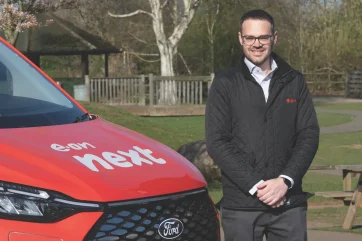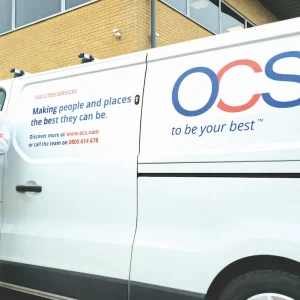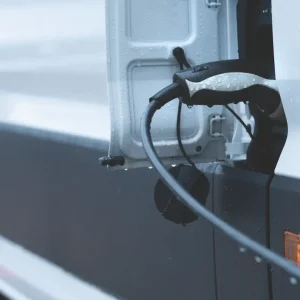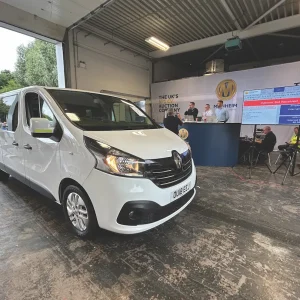
Fitting charge points as part of your day job arguably gives you a leg up with electrifying a fleet, and it’s among the reasons why 90% of energy giant E.ON’s company cars are now EVs.
It got into the plug-in game early, when, in late 2019, the company’s German HQ decided it would electrify its entire European fleet by 2030, and it was no hindrance when UK benefit-in-kind rates for cars hit rock bottom the following April.
Vans, as we know, are harder to electrify. There is no tasty tax break for drivers, and the range, product, payload and availability issues, among others, are very well documented. However, the push from above has propelled E.ON well past the average LCV fleet in electrification terms. At the end of March, it had a total of 579 electric vans, accounting for 32% of its 1,800-strong LCV fleet. That is double this year’s 16% government ZEV mandate requirement for manufacturer electric
van registrations.
The company bought its first plug-in vans – four Vauxhall Vivaro-e models – in 2021, right in the thick of the production shortages. It started as “a bit of a test case”, but the numbers soon increased, as Will Brandwood, fleet strategy manager, tells What Van?.
“We found out it was going to take somewhere between 18 and 24 months for vans to be delivered, so we then decided that four probably wasn’t enough, and we ordered another 200 [electric Vivaros].
“We knew we’d be getting those four first, so it kind of changed from, ‘let’s get them and see what we can learn before we order more,’ to ‘we know we’ll have them for six months before the next ones arrive, so we can work out what challenges we need to overcome in that time’. It was one of those trials where what we learned wasn’t going to change whether we did it or not.”
Staged approach
The firm subsequently ordered a further 150 electric vans, in what Brandwood describes as a “staged approach”. The aim was to electrify the LCV fleet without reducing its ability to do the job which, in E.ON’s case, is transport for the likes of engineers, installers and field support teams. Brandwood says mid-size panel vans comprise about 90% of the vehicles, so it made sense to tackle that first, hence the proliferation of electric Vivaros (the EV fleet also includes Ford E-Transit Customs plus two Vauxhall Combo Electrics) and leave bigger and/or specialist vehicles – cherry pickers, cranes and so on – for later.
While it’s generally acknowledged that the UK’s public charging network still has a way to go, it has moved on during the past four years, and Brandwood was initially factoring in “at least an hour to get probably 50% charge in a van compared to 10 minutes to fill up at a petrol station”.
He is big into driver surveys, too. The first went out at the start of the EV rollout to establish which employees could easily have a home charger installed.
“We started by surveying all 2,000 of the workforce about their home setup and what they could and couldn’t have at their property. Some of those ended up being video surveys, to understand a little bit more – things like, ‘you’ve said on the form that your meter’s here, but we can see where it is, so we might need a bit more cable’.
“We balanced that out with some in-depth analysis on that driver’s behaviour. What’s their mileage on a daily/weekly/monthly basis? What’s the furthest they’re travelling in that period? Within the range of their van, how many times would they need to rely on the public network?”
The analysis was based on telematics data, but the survey results were knottier. Google – about all there was to go on at the time – reckoned around 45% of UK properties could handle a home charger, so Brandwood lowered his expectations to what he thought was a conservative estimate.
“We have a national UK workforce, so bearing in mind a lot of those are going to be in city centres and flats, let’s assume we’re going get about 25%. That wasn’t the case. We ended up with about 12% positive results – much less than we expected.
“There is a second point to that, though, in that some of those were restrictions we put on ourselves. We were not just checking the eligibility of the property but also the eligibility of the employee. If, on paper, it looked as though they’d got enough wiggle room in their daily mileage to complete their work, get home with a few miles to spare, then charge up for the next day, what we didn’t want was for them to get home, then, 20 minutes later, get an emergency callout to somebody vulnerable, then need to wait two hours before they could go. It all comes back to how we continue to do what we’ve always done but in an electric vehicle as opposed to a diesel.”
Changing attitudes
As is the case for pretty much any fleet that tries them, the lack of a blueprint for electric vans, combined with the pace of development, equals a lot of learning on the job. Brandwood was working on the fourth iteration of the driver survey at the time of our interview and noted the comparison between early reticence from drivers, particularly those who had done the job in a diesel van for 20 years, and an attitude that had “changed masses, especially over the last 12 months”.
“There’s more that we’re able to do that we weren’t in 2021, whether that’s because the range has increased so we don’t have the same restrictions, our drivers have changed properties, they’ve had better WiFi put in their house, or they’ve now purchased and they were renting, so they don’t need the landlord’s permission.
“It changes frequently, and we’re seeing a lot more enthusiasm from the drivers themselves, because now, 380-odd of their colleagues [have an EV], everybody knows someone who’s got one, so it’s not just a theory about what it’s going to be like anymore.”
He has moved on to what he calls phase two – issuing electric vans to employees for whom a home charger is not an option. This is often regarded as the sticking point in electrification, and his approach was to set up a working group and geofence the vehicles to keep them within a practical range.
“We gave out 100 [electric] vans to those who cannot have a home charger, so we could look at what that does, and we tracked it every week to see what impact it was having.
“We’ve implemented a new planning system, which has helped to minimise spend. It’s given us much more control about how we keep our drivers under a certain mileage threshold, so we are using what the van is capable of to determine whether somebody can pick up that job or if it needs to be someone else who’s closer.
“We are at a point where it’s not really work-specific – it’s more what you are able to do within the mileage constraints. It’s mostly about how we set that geofence so that it keeps the driver within the radius of support that van is capable of.”





